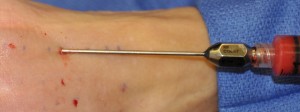Fat grafting in the face has become popular for a variety of reasons, one of which is it purported positive effects on the overlying skin. This has been verified in radiation damaged skin which has shown improvement in vascularity and texture. It has been assumed by anectodal observations that similar effects of fat grafting are also seen in aging skin. Some have credited this to the ballooning effect of underlying volume expansion while others claim that the underlying injected fat changes the actual architecture of the skin.
In the April 2014 issue of the journal Plastic and Reconstructive Surgery, a paper was published entitled ‘Antiaging Treatment of the Facial Skin by Fat Graft and Adipose-Derived Stem Cells’. This study comes from tissue biopsies from six facelift patients. Skin was sampled in front of the ears before and three months after fat injections and expanded mesenchymal stem cells (at the time of the facelift) which were harvested from the abdomen. The skin fragments were analyzed by optical and electron microscopy. After treatment by underlying fat injections the skin showed a decrease in elastic fiber network (elastosis) and the appearance of new oxytalan elastic fibers in papillary dermis. Ultrastructural examination showed a modified tridimensional architecture of the reticular dermis and the presence of a richer microvascular bed. Similar results following treatment with expanded mesenchymal stem cells were also observed.
While this study comes from a very limited sample of patients, it shows that either fat or stem cell injections changes the structure of the skin’s dermis. Such skin changes are suggestive of a rejuvenative effect. Such changes are very hard to quantify and thus what it really means is more suggestive than definitive. It is also unknown why these changes occurs and the current working hypothesis is that it is the result of new blood vessel ingrowth caused by the injectate underneath the skin. (improved dermal microcirculation)

On a practical basis, injectable facial fat grafting is done today almost exclusively for volume restoration whether it be of a congenital, traumatic or facial aging origins. Fat grafting is often part of a facelift procedure for loss of volume in the cheeks and lips for example. Any skin rejuvenation effect is a side benefit. It is still far from practical to be using fat exclusively for an antiaging skin treatment but further supportive studies like this one will surely spurn methods to do so.
Dr. Barry Eppley
Indianapolis, Indiana


